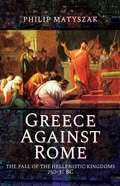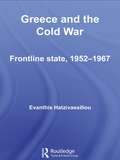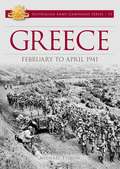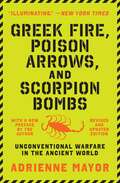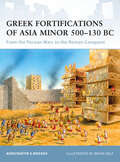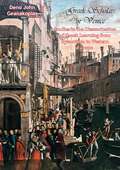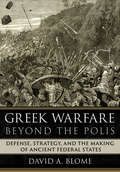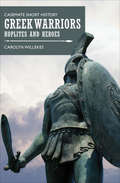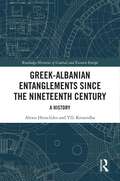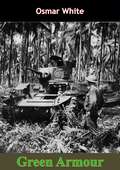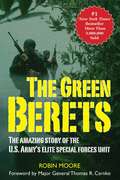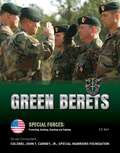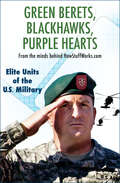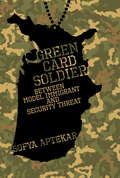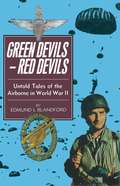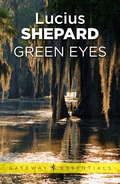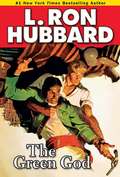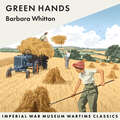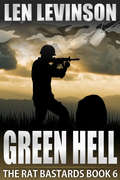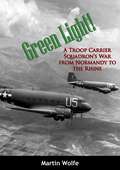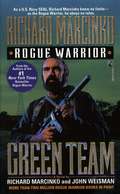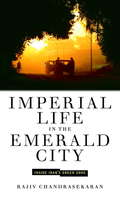- Table View
- List View
Greece Against Rome: The Fall of the Hellenistic Kingdoms 250–31 BC
by Philip MatyszakThe acclaimed ancient world historian examines the centuries-long decline of Greek powers in the face of the growing Roman threat.Towards the middle of the third century BC, the Hellenistic kingdoms were near their peak. In terms of population, economy and military power, each was vastly superior to Rome, not to mention in fields such as medicine, architecture, science, philosophy and literature. But over the next two and a half centuries, Rome would eventually conquer these kingdoms while adopting so much of Hellenistic culture that the resultant hybrid is known as ‘Graeco-Roman’.In Greece Against Rome, Philip Matyszak relates this epic tale from the Hellenistic perspective. At first, the Romans appear to be little more than another small state in the barbarian west as the Hellenistic powers are consumed by war amongst themselves. It is a time of assassinations, double crosses, dynastic incest, and warfare. By the time they turn their attention to Rome, it is already too late .
Greece and the Cold War: Front Line State, 1952-1967 (Cold War History)
by Evanthis HatzivassiliouThis is the first study to present a comprehensive analysis of Greek foreign and internal policy during the Cold War, covering the key period from the country’s accession to NATO in 1952 until the imposition of the colonels’ dictatorship in 1967. Clearly divided into three parts: 1952-55, 1955-63 and 1963-67, this book deals with Greek foreign policy analysis; threat perception; the NATO connection (including Greek-US relations, the rise of anti-Americanism in 1955-58 and in 1964-67, the economic dimension of security and the issue of US military aid); Greek policy towards the Soviet bloc; and the regional dimension, mainly Greek policy towards Turkey and Yugoslavia, and (for the 1964-67 years) the Cyprus crisis which greatly complicated Greek security obligations. This book will be of great interest to students of Greek politics, Balkans history, the Cold War and strategic studies.
Greece: February To April 1941 (Australian Army Campaigns #13)
by Michael TyquinAs with the failed attempt to seize the Gallipoli peninsula in 1915, the allied campaign to assist Greece against a seemingly invincible German juggernaut was poorly conceived and probably doomed even as plans were made to assist that country. Like any campaign, however, it holds lessons for the contemporary student of strategy, tactics and history. Greece presented singular geographic difficulties for the defending forces, its mountainous defiles dictating the distribution of ports, road and rail routes. The primitive state of the national infrastructure did little to help a long-term defensive posture. Operations in Greece proved to be a nightmare, particularly for logistics units, which struggled with primitive communication systems in rugged terrain over which the enemy enjoyed total air superiority. Poor liaison between the Greek and Commonwealth forces did not help matters, nor was the force deployed adequate for its task. The allies never enjoyed air superiority, nor could they consolidate any in-depth defence in time to be effective. The official British history of the campaign stated that the ‘British campaign on the mainland of Greece was from start to finish a withdrawal'. Greece: February to April 1941 explores these complexities, and mistakes through the eyes of the Australian Army Medical Corps.
Greek Fire, Poison Arrows, and Scorpion Bombs: Unconventional Warfare in the Ancient World
by Adrienne MayorA gripping and groundbreaking history of how ancient cultures developed and used biological, chemical, and other unconventional weapons of warFlamethrowers, poison gases, incendiary bombs, the large-scale spreading of disease: are these terrifying agents of warfare modern inventions? Not by a long shot. In this riveting history of the origins of unconventional war, Adrienne Mayor shows that cultures around the world have used biological and chemical weapons for thousands of years—and debated the morality of doing so. Drawing extraordinary connections between the mythical worlds of Hercules and the Trojan War, the accounts of Herodotus and Thucydides, and modern methods of war and terrorism, this richly illustrated history catapults readers into the dark and fascinating realm of ancient war and mythic treachery.
Greek Fortifications of Asia Minor 500-130 BC
by Brian Delf Konstantin NossovSandwiched between the heart of ancient Greece and the lands of Persia, the Greek cities of Western Anatolia were the spark that ignited some of the most iconic conflicts of the ancient world. Fought over repeatedly in the 5th century BC, their conquest by the Persians provided a casus belli for Alexander the Great to cross the Hellespont in 334 BC and launch the battle of Granicus and the sieges of Miletus and Halicarnassus. A blend of Greek and Asian styles of military architecture, these fortified cities were revolutionary in their multi-linear construction - successive defensive walls - with loopholes and mural arches. Konstantin Nossov illustrates the evolution of Greek fortifications and the influences of the region they bordered in this fascinating study.
Greek Naval Strategy and Policy 1910-1919 (Cass Series: Naval Policy And History Ser.)
by Zisis FotakisA sharp analysis of Greek naval history in the 1910s, a time when the importance of its geographic position and its navy increased greatly. It explains the causes of these developments and their consequences for Greek national aims, the Mediterranean naval situation and the Balkan balance of power. Within this context,
Greek Scholars in Venice
by Deno John GeanakoplosTHE MOVEMENT which more than any other served to widen the intellectual horizon of western Europe during the later Middle Ages and the Renaissance was the restoration of Greek letters. In the history of this revival a significant role was played by the Greek scholar-exiles from the Byzantine, or former Byzantine, areas of the East. Beginning in the late fourteenth century and extending well into the sixteenth, a more or less steadily increasing flow of refugees or voluntary exiles from the Greek East—a veritable diaspora—seeking to escape the Turkish domination of their homelands, poured into the West. Many of these émigrés were well educated in the Greek language and literature, and through their work of teaching, manuscript copying, and preparing of texts for the press contributed materially to the advancement of Greek studies in western Europe.Of these exiles the more prominent ones—Chrysoloras, Bessarion, Gaza, Trapezuntios, Argyropoulos, Callistos, Chalcondyles, and Janus Lascaris—have already been the object of considerable attention. But there are scores of others whose careers, less spectacular but perhaps more typical of the experience of the average refugee humanist, have not yet been closely investigated. This book is primarily concerned with the lives of several of these lesser-known figures whose careers are closely associated with the city of Venice in the period of the Renaissance when she attained the primacy in the study of Greek.
Greek Warfare beyond the Polis: Defense, Strategy, and the Making of Ancient Federal States
by David A. BlomeGreek Warfare beyond the Polis assesses the nature and broader significance of warfare in the mountains of classical Greece. Based on detailed reconstructions of four unconventional military encounters, David A. Blome argues that the upland Greeks of the classical mainland developed defensive strategies to guard against external aggression. These strategies enabled wide-scale, sophisticated actions in response to invasions, but they did not require the direction of a central, federal government. Blome brings these strategies to the forefront by driving ancient Greek military history and ancient Greek scholarship "beyond the polis" into dialogue with each other. As he contends, beyond-the-polis scholarship has done much to expand and refine our understanding of the ancient Greek world, but it has overemphasized the importance of political institutions in emergent federal states and has yet to treat warfare involving upland Greeks systematically or in depth. In contrast, Greek Warfare beyond the Polis scrutinizes the sociopolitical roots of warfare from beyond the polis, which are often neglected in military histories of the Greek city-state.By focusing on the significance of warfare vis-à-vis the sociopolitical development of upland polities, Blome shows that although the more powerful states of the classical Greek world were dismissive or ignorant of the military capabilities of upland Greeks, the reverse was not the case. The Phocians, Aetolians, Acarnanians, and Arcadians in circa 490–362 BCE were well aware of the arrogant attitudes of their aggressive neighbors, and as highly efficient political entities, they exploited these attitudes to great effect.
Greek Warriors: Hoplites and Heroes (Casemate Short History)
by Carolyn WillekesA concise, enlightening portrait of the men who fought in the ancient battles we still study today. Thermopylae. Marathon. Though fought 2,500 years ago in ancient Greece, the names of these battles are more familiar to many than battles fought in the last half-century. But our concept of the men who fought in these battles may be more a product of Hollywood than Greece. Shaped by the landscape in which they fought, the warriors of ancient Greece were mainly heavy infantry. While Bronze Age Greeks fought as individuals, for personal glory, the soldiers of the classical city-states fought as hoplites, armed with long spears and large shields, in an organized formation called the phalanx. As well as fighting among themselves, as in the notable thirty-year Peloponnesian War between Athens and Sparta immortalized by Thucydides, the city-states came together to fight outside threats. The Persian Wars lasted nearly half a century and saw the Greek armies come together to fend off several massive Persian forces, both on land and at sea. This book sketches the change from heroic to hoplite warfare, and discusses the equipment and training of both the citizen soldiers of most Greek cities and the professional soldiers of Sparta.
Greek-Albanian Entanglements since the Nineteenth Century: A History (Routledge Histories of Central and Eastern Europe)
by Alexis Heraclides Ylli KromidhaThis book is a comprehensive study of more than 200 years of the shared and interconnected histories of Greek-Albanian relations, a field of inquiry that has not attracted the international scholarly attention it deserves. The book presents and analyses in detail topics including the contested borderland (1800–1912), the Greek Revolution (1821–1830) and Greek-Albanian entanglements during it, Greek nationalism (identity and narrative), the Albanians (pre-modernism, belated nationalism, origin), the rise of Albanian nationalism, Albanian national identity and historical narrative, Greek-Albanian relations from the League of Prizren (1878) until Albania’s declaration of independence (1912), Greek irredentism (the "Northern Epirus Question", 1912–1920) and Albania’s precarious independence, Greek irredentism and Greek-Albanian relations (the "Northern Epirus Question", 1940–1971), the Greek minority in Albania, the Cham (Muslim Albanian) issue, the turbulent first part of the 1990s, the pending Greek-Albanian issues, and public opinion. It concludes with a road map for an eventual Albanian-Greek reconciliation. This volume will interest scholars and students of Southeastern Europe (Balkans), international and political history, political science and sociology. It will also be a valuable resource for diplomats, journalists, think tanks and other organizations and institutions involved in Greek-Albanian relations.
Green Armour
by Osmar WhiteA STORY OF THE JUNGLE AND THE SEA, OF MAN AGAINST NATURE AND MAN AGAINST MAN...GREEN AMOUR is the courageous story of fighting men in the swamps and jungles of New Guinea and the Solomon Islands. From the earliest days of forlorn hopes to the large-scale, well-organised attacks by land, sea, and air his terrifying first-hand account is distilled from the bloody, despairing experiences of the Australian and American forces in the early days of the Second World War..."A brilliant and exciting narrative."--TIMES LITERARY SUPPLEMENT"Osmar White saw more of the bloody action in New Guinea than any other reporter who has yet written about it."--NEW YORK TIMES"Grim, realistic account of the hardships and terrors of jungle warfare."--BRITISH BROADCASTING CORPORATIONGreen Armour is a story of the jungle and the sea, of man against nature, of man against man. It is the story of fighting men in the swamps and jungles of New Guinea, in the islands and atolls and tangled waterways of the Solomon Islands.Its sources were four dog-eared notebooks marked New Guinea, February-October 1942; a diary, with the U.S. Pacific Fleet, April-July 1943; a file of dispatches to Australian Newspapers; and a recollection of certain places, men and events which need no annotation to remain forever sharp in the memory.Written from a knowledge that few, if any, correspondents possessed, Green Armour is a first-hand account of war in the Pacific from the earliest days of forlorn hopes to the large-scale, well-organised attacks by land, sea and air--a taut, terrifying account, distilled from the bloody, despairing experiences of the Australian and American forces in the early years of the World War II.
Green Berets
by Robin Moore Thomas R. CsrnkoIn Vietnam Robin Moore became on the of the first true "embedded” journalists, training and fighting alongside America’s most elite fighters. Though fictionalized, The Green Berets exposed the American public to the horrors of the ground war in Vietnam, and gave the men of the Green Berets the recognition they deserved. Here is the tale of the courageous South Vietnamese girl posing as an anti-American Communist to capture the Viet Cong officer who murdered her family. Here is the graft and double-dealing of South Vietnamese officers undercutting America’s war effort. More importantly, here are America’s soldiers showing unimaginable bravery in the face of a determined and deadly enemy. With a foreword by Major General Thomas R. Csrnko reflecting on the history and future of this elite fighting unit, The Green Berets stands as an enduring classic. "One of the most exciting war books. ” --London Sunday Telegraph
Green Berets (Special Forces: Protecting, Building, Te)
by C. F. EarlKnown around the world for both their skill in combat and their unparalleled ability to survive in harsh, unforgiving conditions, the Green Berets are among America's greatest soldiers. Officially called the U.S. Army Special Forces, the Green Berets work to fight terrorism, rescue hostages, gather intelligence, and defend America's allies abroad. Green Berets examines the history of this elite fighting force, exploring their training standards and special tactics. The book gives readers a detailed look at one of the U.S. Army's most important assets, including: * How the Green Berets are selected and trained * The origin of the berets that U.S. Army Special Forces wear. * How the Green Berets served in the early days of the wars in Iraq and Afghanistan
Green Berets, Blackhawks, Purple Hearts
by HowstuffworksFrom HowStuffWorks.com comes a book chock full of information about the US military and its special units, including their work, their training, and what it takes to be among the best of the bestSEAL Team Six. Army Rangers and Delta Force operators. Green Berets. Who are these highly specialized soldiers? They are the elite units within the US military. They are trained for the performance of extraordinary tasks to preserve peace and protect the United States. Most citizens have heard of the five main branches of the US military: the army, the navy, the air force, the marines, and the coast guard. And those men and women work diligently and bravely to protect our nation. But periodically, news breaks of an uncommon event, like the killing of Osama bin Laden or the Battle of Mogadishu. The startling complexity and delicacy of these operations indicate the intense preparation a smaller group of exceptional soldiers must undergo. The warriors who perform these higher-level operations come from the special-forces teams known as Army Rangers, military snipers, Green Berets, Navy SEALs, and the shadowy Delta Force.Learn about their selection and training, the origins of their unique specialties, and their mission and purpose. Learn what it takes to be truly elite in Green Berets, Blackhawks, Purple Hearts: Elite Units of the US Military.
Green Card Soldier: Between Model Immigrant and Security Threat (Labor and Technology)
by Sofya AptekarAn in-depth and troubling look at a little-known group of immigrants—non-citizen soldiers who enlist in the US military.While the popular image of the US military is one of citizen soldiers protecting their country, the reality is that nearly 5 percent of all first-time military recruits are noncitizens. Their reasons for enlisting are myriad, but many are motivated by the hope of gaining citizenship in return for their service. In Green Card Soldier, Sofya Aptekar talks to more than seventy noncitizen soldiers from twenty-three countries, including some who were displaced by conflict after the US military entered their homeland. She identifies a disturbing pattern: the US military&’s intervention in foreign countries drives migration, which in turn supplies the military with a cheap and desperate labor pool—thereby perpetuating the cycle.As Aptekar discovers, serving in the US military is no guarantee against deportation, and yet the promise of citizenship and the threat of deportation are the carrot and stick used to discipline noncitizen soldiers. Viewed at various times as security threats and members of a model minority, immigrant soldiers sometimes face intense discrimination from their native-born colleagues and superiors. Their stories—stitched through with colonial legacies, white supremacy, exploitation, and patriarchy—show how the tensions between deservingness and suspicion shape their enlistment, service, and identities. Giving voice to this little-heard group of immigrants, Green Card Soldier shines a cold light on the complex workings of US empire, globalized militarism, and citizenship.
Green Devils–Red Devils: Untold Tales of the Airborne in World War II
by Edmund BlandfordWorld War II introduced a new chapter to the history of elite troops - the parachute and glider-borne soldiers of Germany and the Allies, whose story is told in this book. Despite their experimental nature, there is no doubting the successes achieved by both sides. The story of the German airborne corps is traced from its inception - the policemen co-opted into becoming Goering's paras, their army rivals, the revelations of the German disasters, and triumph in Norway, Holland and Belgium before their ultimate test of May 1941. The crucial Battle of Crete is described through the experiences of men who were there, the struggle that broke the back of Hitler's airborne army. Late starters, the British Red Berets came to achieve worldwide fame as crack troops, and the book includes the tales of men who volunteered at the start and saw it through to the end; the triumphs and tragedies of the ordinary soldier, proud to serve in these distinguished regiments. Readers will find not only authentic detail and personal stories, but insights into airborne operations.
Green Eyes (Gateway Essentials #369)
by Lucius ShepardDr Ezawa had made some remarkable discoveries about the Voodoo beliefs that persisted in the Louisiana bayou country - like how to create zombies by injecting corpses with the dirt from old slave graveyards.The eyes of the awoken dead blazed with a brilliant green luminosity, and before they burned out, strange visions and superhuman abilities tormented them.The poet Harrison didn't want to remain a guinea pig. He wanted to find out the truth behind the scientists' sinister manipulations - and he wanted to stay alive.But when he escaped and began to test his growing powers on the superstitious Cajun swamp dwellers, another terrifying world began to unfold before his green eyes...
Green God, The
by L. Ron HubbardPrivate detective Sam Spade nearly died, several times over, chasing The Maltese Falcon. But what Spade faced in pursuit of the black bird was child's play compared to what Lieutenant Bill Mahone of Naval Intelligence endures when he sets out to find the Green God.He's tortured with knives, threatened with a slow, painful death, and buried alive. And then things get really nasty. The entire Chinese city of Tientsin is under siege from within--the streets filled with rioting, arson, mass looting and murder. And all because the city's sacred idol, the Green God, has gone missing. Mahone's convinced he knows who stole the deity of jade, diamonds and pearls. To retrieve it, though, he'll have to go undercover and underground. But he's walking a razor's edge--between worship and warfare, between a touch of heaven and a taste of bloody hell.As a young man, Hubbard visited Manchuria, where his closest friend headed up British intelligence in northern China. Hubbard gained a unique insight into the intelligence operations and spy-craft in the region as well as the criminal trade in sacred objects. It was on this experience that he based The Green God, which was his first professional sale, published in February, 1934--the beginning of a very remarkable and prolific writing career.Also includes the adventure Five Mex for a Million, in which an American Army captain, falsely accused of murder, finds himself taking on the Chinese government, a powerful Russian general, and a mysterious, unexpected passenger.
Green Hands
by Barbara WhittonIt is 1943, and a month into their service as Land Girls, Bee, Anne and Pauline are dispatched to a remote farm in rural Scotland. Here they are introduced to the realities of 'lending a hand on the land', as back-breaking work and inhospitable weather mean they struggle to keep their spirits high.Soon one of the girls falters, and Bee and Pauline receive a new posting to a Northumberland dairy farm. Detailing their friendship, daily struggles and romantic intrigues with a lightness of touch, Barbara Whitton's autobiographical novel paints a sometimes funny, sometimes bleak picture of time spent in the Women's Land Army during the Second World War."Tales from the home front are always more authentic when written from personal experience, as is the case here. Barbara Whitton evokes the highs and lows, joys and agonies of being a Land Girl in the Second World War." -- Julie Summers"Witty, warm and hugely endearing, Barbara Whitton s Green Hands is full of engaging characters, burgeoning friendships and pure hard-graft. A lovely novel for anyone interested in wartime Britain, it leaves the reader with renewed admiration for the indefatigable work of the Women s Land Army." --AJ Pearce(P)2020 Headline Publishing Group Limited
Green Hell: Green Hell (The Rat Bastards Series #6)
by Len LevinsonHell's First Team! They crawl through jungle. Claw through caves. Slog through swamps. Nothing can stop them. And every moment their minds are dominated by a single thought: kill, or die. They take the impossible jobs no ordinary outfit will touch. Because these aren't ordinary men. They're the toughest team in the Pacific War, the one the enemy fears most...The Rat Bastards.
Green Light!: A Troop Carrier Squadron’s War from Normandy to the Rhine
by Martin WolfeIn Green Light!, Martin Wolfe tells the story of another organization in an earlier war whose activities never received much publicity yet had a great impact on various combat operations. During World War II, the 81st Troop Carrier Squadron, as its name implies, carried and dropped paratroopers onto the battlefield, often in the face of heavy enemy fire. Despite sometimes heavy losses in this hazardous and demanding job, the 81st TCS never wavered.This book relates the exploits of the 81st, which mirror the combat experience of all World War II troop carrier units.
Green Lizards vs Red Rectangles: A story about war and peace
by Steve AntonyA brave and thought-provoking picture book about war and peace, from the creator of the much-loved Mr Panda series. The green lizards and the red rectangles are at war. No one can remember why, but they fight and fight... Until one day, a little red rectangle decides to speak up. Can lizards and rectangles find a way to overcome their differences and live peacefully together? Accessible for even the youngest readers, this is the perfect book to start conversations about learning to get along with each other. Steve Antony is the winner of the Evening Standard Oscar's First Book Prize. He's been nominated for the Kate Greenaway Medal and shortlisted for the Waterstones Children's Book Prize.
Green Parrots: A War Surgeon's Diary
by Howard Zinn Gino StradaDesigned to look like toys, green parrots are small, winged cylinders roughly four inches long that flutter over lands devastated by war, but are, in fact, antipersonnel mines. This book introduces us to the endless destruction that the green parrots have spread throughout the world, and in so doing raises an urgent question: Is it legitimate to accept war as an inevitable prospect for current and future generations? After appearing in numerous languages since its initial publication in 1999, this English edition is particularly timely. The appendix of "Green Parrots" contains the complete text of the Universal Declaration of Human Rights, approved on December 10, 1948 by the General Assembly of the United Nations, which begins by proclaiming: "All human beings are born free and equal in dignity and rights. "
Green Team: Rogue Warrior III (Rogue Warrior #3)
by Richard MarcinkoRichard Marcinko's revelations in his explosive #1 bestselling autobiography, Rogue Warrior, reverberated through the highest levels of the US government. But, bound by government restrictions, he was forbidden to tell the whole story. The answer was fiction. First came Rogue Warrior: Red Cell, the take-no-prisoners bestseller with Marcinko as hero. Now the Rogue Warrior's back and he's hotter than ever, in a knockout novel of courage and nonstop action.In Portsmouth, England, an aircraft carrier has been sabotaged, killing the American Chief of Naval Operations, one of the few friends the Rogue Warrior had left in the Navy. Marcinko discovers a holy war is brewing—a violent religious movement, encircling the globe and zeroing in on the West. Defeating that menace will be the supreme test of Marcinko's GREEN TEAM, a top-secret unit operating outside the U.S. military's chain of command. But in Washington, the political wolves select Dick Marcinko as their sacrificial lamb. For the Rogue Warrior it's time to declare a holy war of his own. The enemy may have the ultimate weapon, but GREEN TEAM has Marcinko's Tenth Commandment of SpecWar: There Are No Rules —Thou Shalt Win at All Cost!
Green Zone: Imperial Life in the Emerald City
by Rajiv ChandrasekaranFrom inside a surreal bubble of pure Americana known as the Green Zone, the US-led Coalition Provisional Authority attempted to rule Iraq following the fall of Saddam Hussein's regime. Drawing on interviews and internal documents, Rajiv Chandrasekaran tells the memorable story of this ill-prepared attempt to build American democracy in a war-torn Middle Eastern country, detailing not only the risky disbanding of the Iraqi army and the ludicrous attempt to train the new police force, but absurdities such as the aide who based Baghdad's new traffic laws on those of the state of Maryland, downloaded from the net, and the twenty-four-year-old who had never worked in finance put in charge of revitalising Baghdad's stock exchange. Imperial Life in the Emerald City is American reportage at its best.
